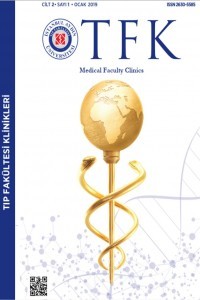Tıp Fakültesi Öğrencilerinin Anatomi Dersi,Anatomi Dersinin İşleyişi ve Materyalleri ile ilgili Görüşleri
ÖZET
Amaç: Bu çalışmanın amacı Van YYÜ Tıp Fakültesi bünyesinde; Anatomi dersinin işleyişi ve tıp fakültesi dönem 1-6 öğrencileriyle özellikle son 2 yılda geçirilen pandemi süreci de düşünülerek Anatomi eğitim süreci ve yeterliliğinin ölçme-değerlendirmesidir.
Gereç ve Yöntem: Çalışmanın amacına uygun olarak 24 soru içeren Anatomi Dersine İlişkin Tutum Ölçeği, 351 öğrenciye çevrimiçi (online) olarak uygulanmıştır. Ölçekte; ‘Hiçbir Zaman’, ‘Nadiren’, ‘Bazen’, ‘Sık sık’ ve ‘Her zaman’ seçeneklerini içeren 5’li likert tipinde 24 soru bulunmaktadır. Her zaman: 1’, ‘Sık sık: 2’, ‘Bazen: 3’, ‘Nadiren: 4’, ‘Hiçbir zaman: 5’ olarak derecelendirilmiştir.
Bulgular: Öğrencilerin sorulara toplamda verdikleri cevaplar baz alınarak Anatomi dersine ilgilerinin ve Anatomi eğitimine karşı tutumlarının;%1,4’ünün düşük düzeyde %38,2’sinin orta düzeyde ve %60.4’ünün ise yüksek düzeyde olduğu görülür. Anatomi Tutum Ölçeği” puan ortalaması ise 92,07±14,43 olarak bulunmuştur.
Sonuç: Anatomi eğitiminde geleneksel yani maket,kadavra,kemik gibi materyallerle yüzyüze eğitimin daha etkili ve daha kalıcı olacağı ama yeni teknolojik eğitim şekillerinin de öğrenciler için yararlı ve cazip olabileceği saptanan çalışmanın sonucunda Anatomi eğitiminin; hekimlik mesleği ve özellikle ileride seçilebilecek cerrahi branşlar açısından birebir uygulamalı şekliyle daha efektif ve kalıcı olacağı düşünülmüştür..
Anahtar Kelimeler: Anatomi,tıp eğitimi,kadavra,tutum ölçeği
SUMMARY
Aim: The aim of this study is within Van YYU Faculty of Medicine; it is the measurement-evaluation of the Anatomy education process and proficiency, considering the functioning of the anatomy course and the pandemic process, especially in the last 2 years, with medical faculty students in terms 1-6.
Materials and Methods: In accordance with the purpose of the study, the Attitude Scale towards the Anatomy Lesson, which includes 24 questions, was administered to 351 students online. In scale; There are 24 questions in 5-point likert type, including 'Never', 'Rarely', 'Sometimes', 'Often' and 'Always'. It is rated always: 1', 'Frequently: 2', 'Sometimes: 3', 'Rarely: 4', 'Never: 5'.
Results: Based on the answers given by the students to the questions in total, it is seen that their interest in Anatomy lesson and their attitudes towards Anatomy education; 1.4% are at low level, 38.2% at medium level and 60.4% at high level. The mean score of "Anatomy Attitude Scale" was found to be 92.07±14.43.
Conclusion: As a result of the study, it was determined that face-to-face education with traditional materials such as models, cadavers, bones in anatomy education would be more effective and more permanent, but that new technological education forms could be beneficial and attractive for students; It is thought that it will be more effective and permanent in terms of the medical profession and especially the surgical branches that may be selected in the future.
Keywords: Anatomy, medical education, cadaver, attitude scale
Anahtar Kelimeler:
Anatomi, Tıp Eğitimi, Kadavra, Tutum Ölçeği
___
- 1. Abdullah Ortadeveci,• Merve Nur Ermez,• Semih Oz,• Hilmi Ozden; A survey study on distance anatomy education: challenges unique to anatomy; Surgical and Radiologic Anatomy https://doi.org/10.1007/s00276-021-02772
- 2. Alsaida, , M. Bertrand; Students’ memorization of anatomy, influence of drawing; Morphologie,Volume 100;Issue 3,28,March 2016;pages 2-6
- 3. Anja Boeckers et al;How can we deal with mental distressin the dissection room?-An evaluation of the need for pyschological support,August 2010
- 4. Bahçeci,D (2006). Anatomi dersinde portfolyo kullanmanın öğrencilerin bilişsel ve duyuşsal özellikleri üzerine etkisi (Yayınlanmış doktora tezi). Gazi Üniversitesi,Eğitim Bilimleri Enstitüsü,Ankara
- 5. B. H. Verhoeven, G. M. Verwijnen, A. J. J. A. Scherpbier et al., “An analysis of progress test results of PBL and non-PBL students,” Medical Teacher, vol. 20, no. 4, pp. 310–316, 1998
- 6. BW Turney;Anatomy in a modern curriculum;Ann R Coll Surg Engl 2007;89:104-107
- 7. İlhan Bahşi, Zehra Topal,Murat Çetkin,Mustafa Orhan, Piraye Kervancıoğlu,Mehmet Ercan Odabaşıoğlu, Ömer Faruk Cihan; Evaluation of attitudes and opinions of medical faculty students against the use of cadaver in anatomy education and investigation of the factors afecting their emotional responses related thereto; Surgical and Radiologic Anatomy (2021) 43:481–487)
- 8. Kaissar Yammine; The Current Status of Anatomy Knowledge: Where Are We Now? Where Do We Need to Go and How Do We Get There?; Teaching and Learning in Medicine, 26(2), 184–188
- 9.Keerti Singh et al;Teaching Anatomy using an active and engaging learning strategy;19:149,2019
- 10.. Louise Ainscough, Richard Leung, and X Kay Colthorpe; Learning how to learn: can embedded discussion boards help first-year students discover new learning strategies?,October 2019
- 11. Mohamed Estai, Stuart Bunt; Best teaching practices in Anatomy education:A critical review,February 2016
- 12. Sevda KÜÇÜK, Samet KAPAKİN, Yüksel GÖKTAŞ; Tıp Fakültesi Öğrencilerinin Mobil Artırılmış Gerçeklikle Anatomi Öğrenimine Yönelik Görüşleri; Yükseköğretim ve Bilim Dergisi, Cilt 5, Sayı 3, Aralık 2015; Sayfa 316-323)
- 13. Triepels, C. P. R., Koppes, D. M., Van Kuijk, S. M. J., Popeijus, H. E., Lamers, W. H., Van Gorp, T., ... & Notten, K. J. B. (2018). Medical students’ perspective on training in anatomy. Annals of Anatomy-Anatomischer Anzeiger, 217, 60-65.
- 14. Veronica Papa ,Mauro Vaccarezza; Teaching Anatomy in the XXI Century: New Aspects and Pitfalls; Hindawi Publishing Corporation The Scientific World Journal Volume 2013, Article ID 310348, 5 pages
- ISSN: 2630-5585
- Başlangıç: 2018
- Yayıncı: İstanbul Aydın Üniversitesi
Sayıdaki Diğer Makaleler
Burak KARİP, Özlem ÖZTÜRK KÖSE, Seren KAYA, Rabia SOLAK DÖNER
Radyasyon rektiti (proktiti) ve argon plazma koagülasyonu
Ahmet UYANIKOĞLU, Emine ÇAKICI, Süleyman SARİ
Uterus rüptürü gelişen 3 olguda konservatif tedavi ve sonuçları ile birlikte literatür derlemesi
SINIFLANDIRILMAYAN YEME DAVRANIŞ BOZUKLUĞU OLAN ORTOREKSİYA NERVOZA’YA YAKLAŞIM
